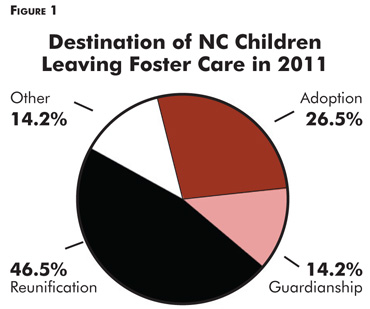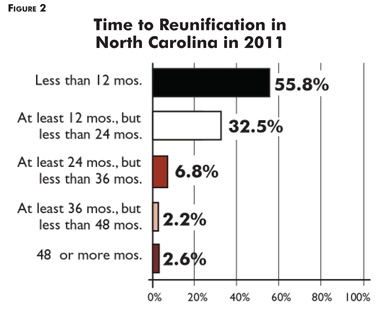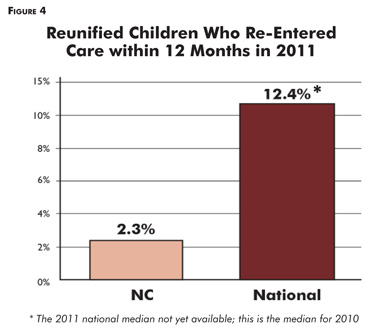 |
 |
 |
Vol.
18, No. 3
June 2013
Reunification in North Carolina: How Are We Doing?
As child welfare professionals, it helps us to undertand what happens to children and families involved with the child welfare system. Below you'll find some key things you should know about the reunification of children in foster care in North Carolina.
Reunification is the most likely outcome for children placed in foster care. In 2011, of the 4,805 children who left foster care in our state, 2,234 (46.5%) were reunified with their families. Figure 1 illustrates the different destinations of the children who left foster care in North Carolina in 2011.

Reunification is somewhat less likely than it was in 2007. The percentage of children leaving foster care through reunification declined from 50.1% in 2007 to 46.5% in 2011. During this same period the percentage of exits to adoption increased slightly, from 24.2% to 26.5%, while exits to "other" rose from 11% to 14.2%. "Other" is a category that includes emancipation, transfer to another agency, runaway, or death of child. Emancipations account for most exits in this category.
When it occurs, reunification usually happens in less than 12 months. Of the North Carolina children reunified in 2011, 55.8% spent less than 12 months in foster care. This percent falls short of the national median of 69.9%. Figure 2 illustrates the amount of time the NC children who were reunified in 2011 spent in foster care before returning home.

Time to reunification is improving. Of the North Carlina children in foster care who were reunified in 2009, 52.3% were reunified in less than 12 months. By 2011 our performance on this measure had increased to 55.8%. Although this is encouraging, our state lags behind most of the country when it comes to reunification within 12 months (Duncan, 2012).
Reunification becomes less likely the longer children are in care. For example, of the children who entered foster care in state fiscal year 2009-10 and spent less than a year in custody, half were reunified. By contrast, just 20% of those who spent more than 2 years in custody were reunified with their families (Duncan, et al., 2013).
Small counties are not doing as well on reunification. Children in the custody of small NC counties are less likely to be reunified in 12 months than other children in foster care. While there has been considerable variation in the performance of large and mid-size counties since 2000, as Figure 3 illustrates, during this time small counties consistently lagged behind on exits to reunification within 12 months (Duncan, et al., 2013).

Given this fact, it is not surprising that in small counties children typically spend more time in foster care before being reunified. Since 2000, children in small counties exiting to reunification spend about 10.5 months in foster care--well above the federal median of 6.5 months (Duncan, et al., 2013; USDHHS, 2012).
Reunification was not equally likely for children of all races/ethnicities in North Carolina in 2011. Although reunification was the most likely outcome for children of all races in 2011, White (non-Hispanic) children were somewhat more likely to be reunified than Black (non-Hispanic) children (46.8% vs. 44.2%), while Hispanic children (any race) were reunified more often than White children (53.8% vs. 46.8%).
North Carolina performs quite well on re-entry into foster care. Although children in our state are not reunified as swiftly as in other states, very few re-enter foster care.
In 2011, only 2.3% of children entering foster care in North Carolina had been in foster care during the preceding 12 months. As Figure 4 illustrates, this is significantly lower than the national median for this performance measure.

This suggests North Carolina does a better job than many states of ensuring that sufficient changes have occurred in birth families before children return home and/or that sufficient post-reunification services are provided.
